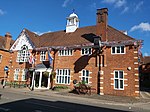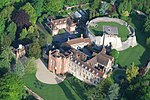Park Lane Chapel, Farnham
1844 establishments in England19th-century Baptist churches19th-century churches in the United KingdomChurches completed in 1852EngvarB from November 2015 ... and 5 more
FarnhamFormer Baptist churches in EnglandFormer churches in SurreyGrade II listed churches in SurreyStrict Baptist chapels

The building formerly known as Park Lane Chapel is a former Strict Baptist chapel in the ancient town of Farnham in Surrey, England. Now a house, it was in religious use for nearly 150 years and housed a congregation whose origins go back to informal meetings in the 1840s. After Nisan Samuel, a Polish Jew, arrived in England and converted to Christianity, he took charge of these ad hoc meetings and formalised them into a Strict Baptist church. After he moved on, the congregation bought land and built a chapel. The small stone and brick building has been listed at Grade II for its architectural and historical importance.
Excerpt from the Wikipedia article Park Lane Chapel, Farnham (License: CC BY-SA 3.0, Authors, Images).Park Lane Chapel, Farnham
High Park Road, Waverley
Geographical coordinates (GPS) Address Nearby Places Show on map
Geographical coordinates (GPS)
| Latitude | Longitude |
|---|---|
| N 51.216585 ° | E -0.798528 ° |
Address
High Park Road
GU9 7JL Waverley
England, United Kingdom
Open on Google Maps








